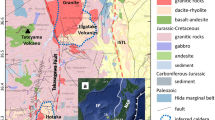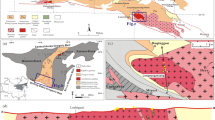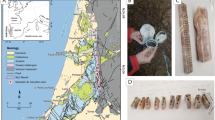Abstract
The Donegal granites in north-west Ireland are among the best mapped granitic intrusions in the world1. They form part of a broad suite of granites intruded during the Palaeozoic but within a relatively small area encompass a wide range of emplacement features. A published Rb–Sr composite whole rode isochron for these granites defined a date of 487±5 Myr (refs 2, 3) whereas K–Ar ages exhibited a spread from 365±8 to 412±8 Myr (refs 1, 4). (All age data are normalized to recently recommended decay constants5). Although some doubt was cast on the older Rb–Sr date by Pitcher and Berger (ref. 1, p. 90) and Leake6 it has generally been accepted as a more valid estimate of the emplacement age2,3,7–9. Here we summarize the results of Rb–Sr and U–Pb isotopic analyses recently carried out which indicate that the Rosses, Ardara, Trawenagh Bay and Main Donegal intrusions were, in fact, all emplaced close to 400 Myr ago.
This is a preview of subscription content, access via your institution
Access options
Subscribe to this journal
Receive 51 print issues and online access
$199.00 per year
only $3.90 per issue
Buy this article
- Purchase on Springer Link
- Instant access to full article PDF
Prices may be subject to local taxes which are calculated during checkout
Similar content being viewed by others
References
Pitcher, W. S. & Berger, A. R. The Geology of Donegal: A Study of Granite Emplacement and Unroofing (Wiley-Interscience, London, 1972).
Leggo, P. J., Tanner, P. W. G. & Leake, B. E. in North Atlantic Geology and Continental Drift 354–362 (Memoir 12, American Association of Petroleum Geologists) (1969).
Leggo, P. J. & Pidgeon, R. T. Eclog. geol. Helv. 63, 207–212 (1970).
Brown, P. E., Miller, J. A. & Grasty, R. L. Proc. Yorks. geol. Soc. 36, 251–276 (1968).
Steiger, R. H. & Jäger, E. Earth planet. Sci. Lett. 36, 359–362.
Leake, B. E. Geol. J. Spec. Iss. No. 10, 221–248 (1978).
Phillips, W. E. A., Stillman, C. J. & Murphy, T. J. geol. Soc. Lond. 132, 579–609 (1976).
Lambert, R. St. J. & McKerrow, W. S. Scott. J. Geol. 12, 271–292 (1976).
Pankhurst, R. J., Andrews, J. R., Phillips, W. E. A., Sanders, I. S. & Taylor, W. E. G. J. geol. Soc. Lond. 132, 327–336 (1976).
Halliday, A. N., Aftalion, M., van Breemen, O. & Jocelyn, J. in The Caledonides of the British Isles—Reviewed, 653–662 (Geological Society of London Spec. Publ.) (1980).
York, D. Earth planet Sci. Lett. 5, 320–324 (1969).
Pankhurst, R. J. in Origin of Granite Batholiths-Geochemical Evidence, 18–33 (Shiva, Orpington, 1979).
Stephens, W. E. & Halliday, A. N. in Origin of Granite Batholiths—Geochemical Evidence, 9–17 (Shiva, Orpington, 1979).
Halliday, A. N., Stephens, W. E. & Harmon, R. S. J. geol. Soc. Lond. (in the press).
Pidgeon, R. T. & Aftalion, M. Geol. J. Spec. Iss. No. 10, 183–220 (1978).
Long, L. E. Abstr. Conf. The Caledonides of the British Isles—Reviewed, 41–42 (Dublin, 1978).
Read, H. H. Geol J. 2, 653–683 (1961).
Author information
Authors and Affiliations
Rights and permissions
About this article
Cite this article
Halliday, A., Aftalion, M. & Leake, B. A revised age for the Donegal granites. Nature 284, 542–543 (1980). https://doi.org/10.1038/284542a0
Received:
Accepted:
Issue Date:
DOI: https://doi.org/10.1038/284542a0
Comments
By submitting a comment you agree to abide by our Terms and Community Guidelines. If you find something abusive or that does not comply with our terms or guidelines please flag it as inappropriate.



